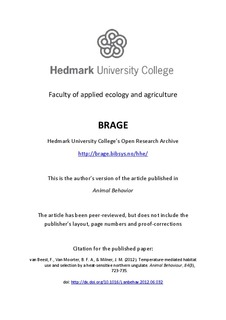| dc.contributor.author | van Beest, Floris | |
| dc.contributor.author | van Moorter, Bram | |
| dc.contributor.author | Milner, Jos | |
| dc.date.accessioned | 2012-12-06T10:21:17Z | |
| dc.date.available | 2012-12-06T10:21:17Z | |
| dc.date.issued | 2012 | |
| dc.identifier.citation | van Beest, F., Van Moorter, B. F. A., & Milner, J. M. (2012). Temperature-mediated habitat use and selection by a heat-sensitive northern ungulate. Animal Behaviour, 84(3), 723-735. doi: http://dx.doi.org/10.1016/j.anbehav.2012.06.032 | no_NO |
| dc.identifier.issn | 0003-3472 | |
| dc.identifier.uri | http://hdl.handle.net/11250/134154 | |
| dc.description | This is the postprint version of the article. The published version can be located on the publisher's webpage | no_NO |
| dc.description.abstract | While the behavioural response of animals to unfavourable climatic conditions has received increased attention recently, most habitat selection studies nonetheless ignore effects of ambient temperature. Thermoregulatory behaviour in endotherms should be most notable in species susceptible to heat stress. We evaluated whether a heat-sensitive northern ungulate, the moose (Alces alces), showed thermoregulatory behaviour in response to ambient temperature in two populations in southern Norway. We quantified the seasonal habitat use of GPS-collared adult females, as well as fine-scale habitat selection patterns, in relation to time of day and critical temperature thresholds thought to induce heat stress. We also assessed whether temperature driven changes in spatial behaviour led to a trade-off between thermal cover and forage availability. Frequent exposure to temperatures above critical thresholds occurred in both summer and winter and in both study areas. Moose responded by seeking thermal shelter in mature coniferous forest and avoiding open habitat types, leading to a trade-off between forage and cover availability in summer but not winter. Differences in habitat choice in response to temperature were most pronounced at twilight. We found that fine-scale habitat selection analyses, using step selection functions, more effectively revealed thermoregulatory behaviour in both seasons and populations than habitat use. This is because habitat selection analyses are better able to identify limiting factors operating at different spatiotemporal scales than habitat use. Future studies on thermoregulatory animal behaviour should focus on the effect of abiotic factors, such as climate, on habitat-fitness relationships, which may be critical to understanding population responses to a changing climate. | no_NO |
| dc.language.iso | eng | no_NO |
| dc.subject | climate change | no_NO |
| dc.subject | deer | no_NO |
| dc.subject | endotherms | no_NO |
| dc.subject | habitat selection | no_NO |
| dc.subject | SSF | no_NO |
| dc.subject | thermoregulation | no_NO |
| dc.subject | trade-off | no_NO |
| dc.title | Temperature-mediated habitat use and selection by a heat-sensitive northern ungulate. | no_NO |
| dc.type | Journal article | no_NO |
| dc.type | Peer reviewed | no_NO |
| dc.subject.nsi | VDP::Mathematics and natural science: 400::Zoology and botany: 480 | no_NO |
| dc.source.pagenumber | 723-735 | no_NO |
| dc.source.volume | 84 | no_NO |
| dc.source.journal | Animal Behavior | no_NO |
| dc.source.issue | 3 | no_NO |
| dc.identifier.doi | http://dx.doi.org/10.1016/j.anbehav.2012.06.032 | |
